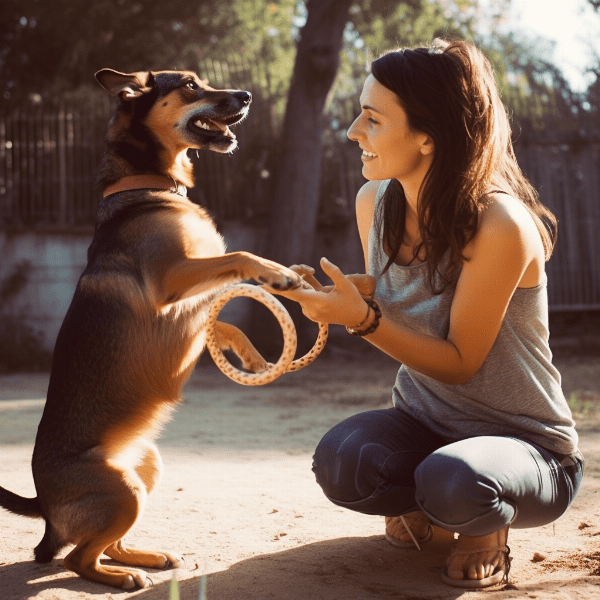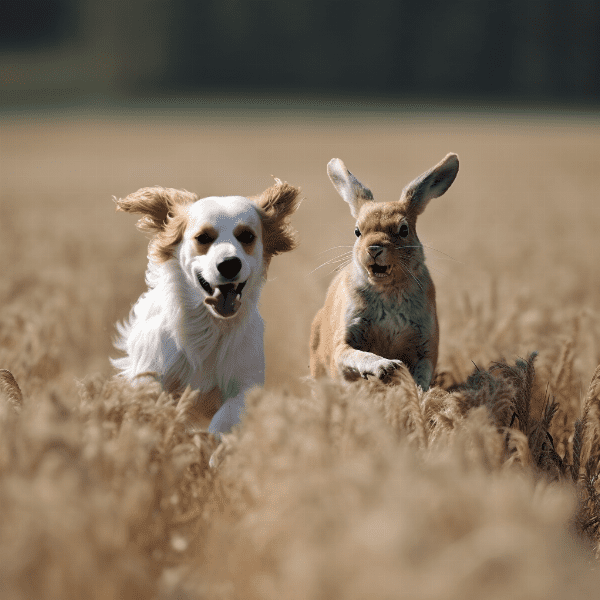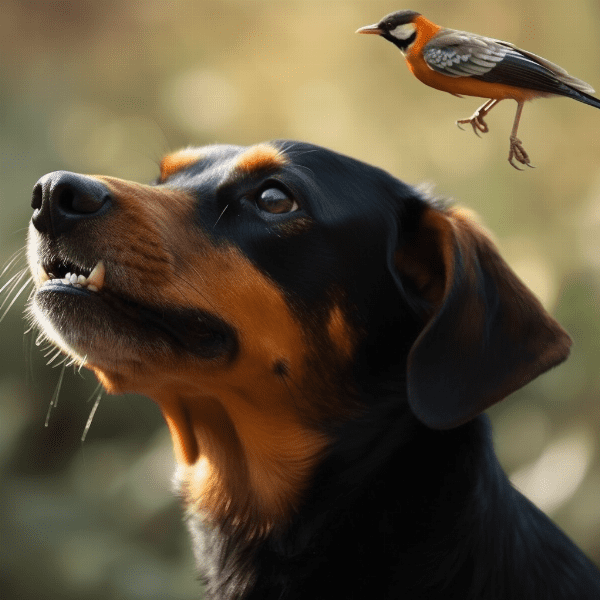Table of Contents
- Introduction: Why Do Dogs Chase Their Tails?
- Basic Tail-Chasing Behaviors to Watch For
- Training Your Dog to Chase Their Tail on Command
- Tail-Chasing Games to Play With Your Dog
- Preventing Excessive Tail-Chasing Behavior
- When to Be Concerned About Your Dog’s Tail-Chasing
- The Science Behind Tail-Chasing Behavior in Dogs
- Other Fun Tricks to Teach Your Dog
- Conclusion: Enjoying the Endless Entertainment of Tail-Chasing
Introduction: Why Do Dogs Chase Their Tails?
Dogs chasing their tails is a behavior that has entertained and puzzled dog owners for centuries. It is a common sight to see dogs spinning around in circles, trying to catch their own tails, but why do they do it? In this section, we’ll explore some of the reasons why dogs engage in this behavior.
The Instinct to Chase
One of the most basic reasons why dogs chase their tails is that it is an instinctual behavior. Dogs are natural predators, and chasing small, fast-moving objects is a part of their hunting instinct. In the absence of prey, dogs may redirect this instinctive behavior towards their own tails.
Boredom and Excess Energy
Another reason why dogs may chase their tails is simply because they are bored or have excess energy. Dogs who are not getting enough physical or mental stimulation may engage in repetitive or compulsive behaviors, such as tail-chasing, as a way to alleviate their boredom or pent-up energy.
Stress and Anxiety
Finally, dogs may also chase their tails as a result of stress or anxiety. Dogs who are feeling anxious or overwhelmed may engage in repetitive behaviors, such as tail-chasing, as a way to self-soothe and cope with their stress.
Overall, tail-chasing is a common behavior in dogs, and there are a variety of reasons why they may engage in it. While it is usually harmless, it is important for dog owners to be aware of their pet’s behavior and to seek veterinary help if they are concerned about any underlying medical issues. In the following sections, we’ll explore some of the different tail-chasing behaviors and techniques that can be used to train and entertain your furry friend.

Basic Tail-Chasing Behaviors to Watch For
As a dog owner, it’s important to understand the different types of tail-chasing behaviors that your dog may exhibit. In this section, we’ll explore some of the basic tail-chasing behaviors to watch for in your furry friend.
The Circle-Chaser
The most common type of tail-chasing behavior is the circle-chaser. Dogs who exhibit this behavior will typically spin around in a circle, trying to catch their tails as they go. Circle-chasers may be seen doing this behavior for short periods of time or for longer periods of time, depending on the individual dog.
The Sudden-Chaser
Another type of tail-chasing behavior is the sudden-chaser. Dogs who exhibit this behavior may suddenly bolt off in a direction and start chasing their tails. This behavior may be triggered by excitement or by something that has caught the dog’s attention.
The Non-Stop-Chaser
The non-stop-chaser is a type of tail-chaser who just can’t seem to stop. Dogs who exhibit this behavior will chase their tails for extended periods of time, often to the point of exhaustion. This type of behavior can be a sign of an underlying medical issue or a lack of physical or mental stimulation.
The One-Time-Chaser
Finally, there is the one-time-chaser. Dogs who exhibit this behavior may only chase their tails once or twice in their lifetime, and then never again. This type of behavior is usually harmless and may be triggered by boredom or curiosity.
Overall, tail-chasing behaviors can vary from dog to dog, and it’s important to understand the different types of behaviors that your furry friend may exhibit. If you notice any unusual tail-chasing behaviors or are concerned about your dog’s behavior, it’s always best to consult with your veterinarian to rule out any underlying medical issues. In the following sections, we’ll explore some of the different techniques that can be used to train your dog to chase their tail on command, as well as some fun tail-chasing games to play with your furry friend.

Training Your Dog to Chase Their Tail on Command
While tail-chasing is a natural behavior for dogs, you can also train your furry friend to chase their tail on command. This can be a fun and entertaining trick that can also help to provide your dog with mental and physical stimulation. In this section, we’ll explore some techniques for training your dog to chase their tail on command.
Step 1: Establish a Cue
The first step in training your dog to chase their tail on command is to establish a cue. This could be a verbal cue, such as “chase your tail”, or a physical cue, such as a hand signal. Once you have established the cue, you can start to use it to encourage your dog to chase their tail.
Step 2: Encourage Tail-Chasing
To encourage your dog to chase their tail, you can start by using a toy or treat to get their attention. Hold the toy or treat near your dog’s tail, and when they start to show interest, give the cue to chase their tail. If your dog starts to spin around in a circle, praise them and reward them with the toy or treat.
Step 3: Repeat and Reinforce
Repeat this process several times, gradually phasing out the use of the toy or treat as your dog becomes more comfortable with the behavior. Be sure to praise and reward your dog each time they successfully chase their tail on command. Over time, your dog will start to associate the cue with the behavior, and you will be able to use it to encourage them to chase their tail without the need for a toy or treat.
Step 4: Practice, Practice, Practice
As with any training technique, it’s important to practice regularly to reinforce the behavior. Set aside a few minutes each day to work on tail-chasing with your furry friend. You can also incorporate tail-chasing into other training exercises to provide additional mental and physical stimulation.
Training your dog to chase their tail on command can be a fun and entertaining trick that provides your dog with mental and physical stimulation. However, it’s important to be patient and consistent in your training, and to always keep your dog’s safety and well-being in mind. In the following sections, we’ll explore some fun tail-chasing games to play with your furry friend.

Tail-Chasing Games to Play With Your Dog
Game 1: Hide and Seek
One fun tail-chasing game to play with your dog is hide and seek. To play, start by hiding a favorite toy or treat in a location where your dog can find it. Then, encourage your dog to find the toy or treat by using the tail-chasing cue. As your dog searches for the toy or treat, they will naturally engage in tail-chasing behavior, providing them with mental and physical stimulation.
Game 2: Laser Pointer
Another fun tail-chasing game is to use a laser pointer to create a moving target for your dog to chase. Be sure to use a pet-safe laser pointer, and avoid shining the laser in your dog’s eyes. As your dog chases the laser pointer, they will engage in tail-chasing behavior, providing them with physical exercise and mental stimulation.
Game 3: Fetch and Chase
A third tail-chasing game to play with your dog is fetch and chase. Start by playing a game of fetch with your dog, using a favorite toy. Then, when your dog brings the toy back to you, use the tail-chasing cue to encourage them to chase their tail for a few seconds before throwing the toy again. This game provides your dog with a combination of physical exercise and mental stimulation, while also strengthening the bond between you and your pet.
Game 4: Agility Course
Finally, you can also incorporate tail-chasing into an agility course for your dog. Set up an obstacle course in your backyard or at a local park, including jumps, tunnels, and other agility equipment. Then, use the tail-chasing cue to encourage your dog to chase their tail as they navigate the course. This game provides your dog with both mental and physical stimulation, while also challenging them to use their problem-solving skills.
Overall, tail-chasing games provide your dog with mental and physical stimulation, while also strengthening the bond between you and your furry friend. When playing tail-chasing games, be sure to always keep your dog’s safety and well-being in mind, and to choose games that are appropriate for your dog’s age, size, and fitness level.

Preventing Excessive Tail-Chasing Behavior
Provide Adequate Physical and Mental Stimulation
One of the best ways to prevent excessive tail-chasing behavior is to provide your dog with adequate physical and mental stimulation. This can include daily walks, playtime, and training exercises that challenge your dog’s problem-solving skills. Providing your dog with plenty of stimulation can help to alleviate boredom and reduce the likelihood of compulsive behaviors, such as excessive tail-chasing.
Address Underlying Medical Issues
If your dog is experiencing itching or discomfort in their tail, hips, or legs, they may engage in excessive tail-chasing behavior as a way to alleviate their discomfort. If you suspect that your dog is experiencing an underlying medical issue, it’s important to consult with your veterinarian to address the issue and provide appropriate treatment.
Manage Stress and Anxiety
Stress and anxiety can also contribute to excessive tail-chasing behavior in dogs. To manage stress and anxiety, provide your dog with a comfortable and secure environment, regular exercise, and plenty of positive reinforcement. You can also consider using calming aids, such as pheromone sprays or supplements, to help alleviate your dog’s anxiety.
Avoid Reinforcing Tail-Chasing Behavior
Finally, it’s important to avoid inadvertently reinforcing excessive tail-chasing behavior in your dog. Avoid giving your dog attention or treats when they engage in excessive tail-chasing behavior, as this can reinforce the behavior and make it more likely to occur in the future. Instead, focus on providing positive reinforcement for appropriate behaviors, such as obedience training and other desirable behaviors.
By providing your dog with adequate physical and mental stimulation, addressing underlying medical issues, managing stress and anxiety, and avoiding reinforcing excessive tail-chasing behavior, you can help to prevent compulsive tail-chasing behavior in your furry friend. If you are concerned about your dog’s tail-chasing behavior, or if you suspect that your dog is experiencing an underlying medical issue, be sure to consult with your veterinarian for advice and guidance.

When to Be Concerned About Your Dog’s Tail-Chasing
While tail-chasing is a common behavior in dogs, excessive or compulsive tail-chasing can be a sign of an underlying medical or behavioral issue. In this section, we’ll explore some signs to look for to determine if your dog’s tail-chasing behavior is a cause for concern.
Duration and Frequency
One of the first signs to look for is the duration and frequency of your dog’s tail-chasing behavior. If your dog is chasing their tail for long periods of time, or if they are engaging in the behavior frequently throughout the day, it may be a sign of compulsive behavior.
Agitation and Anxiety
Another sign to look for is agitation or anxiety in your dog when they are engaging in tail-chasing behavior. If your dog is becoming increasingly agitated or anxious as they chase their tail, it may be a sign that the behavior is causing them distress.
Injury or Irritation
If your dog is chasing their tail excessively, it can also lead to injury or irritation of the tail or surrounding areas. Look for signs of redness, swelling, or irritation around the tail, as well as any signs of injury, such as broken or bleeding skin.
Other Compulsive Behaviors
Finally, if your dog is engaging in other compulsive behaviors, such as excessive licking, chewing, or scratching, it may be a sign of an underlying behavioral issue. If you notice these types of behaviors in addition to tail-chasing, it’s important to consult with your veterinarian to rule out any underlying medical or behavioral issues.

The Science Behind Tail-Chasing Behavior in Dogs
Tail-chasing behavior is a common behavior in dogs, but the reasons behind this behavior are not fully understood. In this section, we’ll explore some of the theories and research behind tail-chasing behavior in dogs.
Natural Instincts
One theory behind tail-chasing behavior is that it is a natural instinct in dogs. Wild canines, such as wolves and coyotes, use tail-chasing behavior as a way to practice their hunting skills and improve their agility. It’s possible that this behavior has been retained in domesticated dogs as a vestigial trait from their wild ancestors.
Boredom and Lack of Stimulation
Another theory behind tail-chasing behavior in dogs is that it is a sign of boredom or a lack of physical or mental stimulation. Dogs who are left alone for long periods of time or who do not receive adequate exercise or mental stimulation may engage in tail-chasing behavior as a way to alleviate their boredom.
Compulsive Behavior
Excessive or compulsive tail-chasing behavior may be a sign of a compulsive disorder in dogs. This type of behavior is thought to be similar to obsessive-compulsive disorder (OCD) in humans, and may be triggered by anxiety, stress, or a lack of environmental stimulation. Compulsive tail-chasing behavior may also be linked to certain genetic or neurological factors.
Medical Issues
In some cases, tail-chasing behavior may be a sign of an underlying medical issue. Dogs who are experiencing pain, discomfort, or irritation in their tail, hips, or legs may engage in tail-chasing behavior as a way to alleviate their discomfort. It’s important to consult with your veterinarian if you suspect that your dog’s tail-chasing behavior is linked to a medical issue.

Other Fun Tricks to Teach Your Dog
In addition to tail-chasing, there are a variety of other fun tricks that you can teach your dog. These tricks can provide your furry friend with mental and physical stimulation, while also strengthening the bond between you and your pet. In this section, we’ll explore some other fun tricks to teach your dog.
Shake
One fun trick to teach your dog is to shake. To teach your dog to shake, start by getting your dog’s attention and holding out your hand. When your dog sniffs your hand or paw at it, say “shake” and take their paw in your hand. Praise and reward your dog each time they successfully shake your hand.
Speak
Teaching your dog to speak can also be a fun trick. To teach your dog to speak, start by holding a treat in front of your dog’s nose. When your dog starts to bark or make noise, say “speak” and give them the treat. Repeat this process, gradually phasing out the use of the treat as your dog becomes more comfortable with the behavior.
Play Dead
A final fun trick to teach your dog is to play dead. To teach your dog to play dead, start by getting your dog to lie down. Then, use a treat to guide your dog’s head towards the ground, encouraging them to lie on their side. Praise and reward your dog each time they successfully play dead.
Overall, teaching your dog fun tricks can provide them with mental and physical stimulation, while also strengthening the bond between you and your furry friend. When teaching your dog tricks, be sure to use positive reinforcement and to be patient and consistent in your training. With a little practice and patience, your dog can learn a variety of fun and entertaining tricks.

Conclusion: Enjoying the Endless Entertainment of Tail-Chasing
Tail-chasing behavior is a common and entertaining behavior in dogs that can provide them with mental and physical stimulation. By understanding the reasons behind this behavior and incorporating tail-chasing into training and playtime, you can provide your furry friend with endless entertainment.
The Benefits of Tail-Chasing
Tail-chasing provides your dog with both mental and physical stimulation, promoting their overall health and well-being. It also strengthens the bond between you and your pet, providing a fun and entertaining way to interact with your furry friend.
Techniques for Training and Playing
In this guide, we explored a variety of techniques for training and playing with your dog, including teaching your dog to chase their tail on command, playing tail-chasing games, and teaching other fun tricks. By incorporating these techniques into your daily routine, you can provide your dog with plenty of mental and physical stimulation.
When to Be Concerned
While tail-chasing behavior is natural in dogs, excessive or compulsive tail-chasing can be a sign of an underlying medical or behavioral issue. If you are concerned about your dog’s tail-chasing behavior, or if you notice any signs of discomfort or injury, be sure to consult with your veterinarian for advice and guidance.
Overall, tail-chasing behavior in dogs is a fun and entertaining behavior that can provide your furry friend with endless entertainment. By incorporating tail-chasing into your training and playtime, you can provide your dog with mental and physical stimulation, while also strengthening the bond between you and your furry friend.




